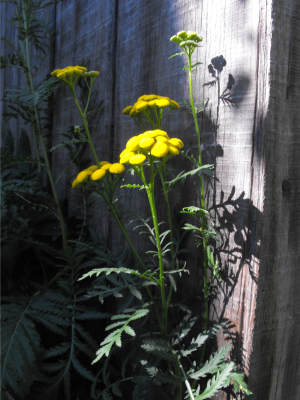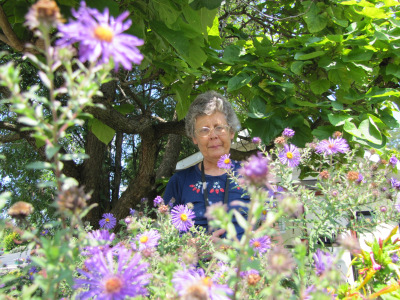
Tansy (Tanacetum vulgare)
 I've
had tansy ever since my mother brought a start to me from South
Weymouth, Massachusetts, probably from her own yard, and probably, too,
originally from her sister, Ruth
Tirrell. My
mother
would have little
sprigs of the tansy flower mixed in with barberry bush sprigs, in a
vase
on her windowsill over the sink. These little "button" seedheads
stay
yellow for ages, and keep their bitter, aromatic smell even longer.
I've
had tansy ever since my mother brought a start to me from South
Weymouth, Massachusetts, probably from her own yard, and probably, too,
originally from her sister, Ruth
Tirrell. My
mother
would have little
sprigs of the tansy flower mixed in with barberry bush sprigs, in a
vase
on her windowsill over the sink. These little "button" seedheads
stay
yellow for ages, and keep their bitter, aromatic smell even longer.
The
reason for tansy was to keep ants away. In my mother's kitchen
this never
seemed to work! But I guess she kept tansy as a comforting
decoration,
anyway!
I've looked up a tansy
cookie
recipe, in the Rodales
Herb
Book, ed. by
Williamk Huilton, 1974: Beat 1/2 c. honey and 1/2 c. butter. Add
1 egg,
then 2 c. whole wheat flour, 1/4 tsp. baking soda, 1/4 tsp. salt, 1
tsp.vanilla and
1 1/2 tsp. tansy (probably dried leaves), plus 1 tbsp. yoghurt.
Roll out to
1/8 in. thick, cut into rounds, sprinkle with more tansy and bake at
375
for 10 min.
Because it is a "bitter
herb"
the cookies were eaten at Easter, and the
dried leaves were eaten at Passover. The seeds can be eaten
as a worm
expellent. There are other medicinal uses, of the tea brewed from
the
leaves: for eye imflammtion and styes, and in compresses  for
varicose
veins!
for
varicose
veins!
Tansy is supposed to
deter
mosquitoes, and squash bugs, besides ants.
Some say it therefore attracts aphids. Some say it deters
cucumber
beetles, some say it attracts them. I have my tansy tangled up
with a
volunteer blackberry vine, and have never had Japanese beetles
there. Some
others plant tansy under fruit trees.
This is a ferny perennial
that
is started best from small starts, not
seeds. Mine has grown to 6 feet, taller than the usual 4.
Worth growing
for its distinctive smell and flowers.
| This post is part of our Urban Homesteading lunchtime series.
Read all of the entries: |
Want more in-depth information? Browse through our books.
Or explore more posts by date or by subject.
About us: Anna Hess and Mark Hamilton spent over a decade living self-sufficiently in the mountains of Virginia before moving north to start over from scratch in the foothills of Ohio. They've experimented with permaculture, no-till gardening, trailersteading, home-based microbusinesses and much more, writing about their adventures in both blogs and books.
Want to be notified when new comments are posted on this page? Click on the RSS button after you add a comment to subscribe to the comment feed, or simply check the box beside "email replies to me" while writing your comment.

Adrianne I am enjoying your posts - hope Anna keeps you "on" Rosenell and I would like to get a start of this tansy! Keep up the great work! Jayne
Jerry --- I'm not too surprised --- so many things we grow turn invasive somewhere. I'm curious to hear where you live. Luckily, Mom shouldn't have any trouble in her little city backyard.
Jayne --- Thanks so much for the positive feedback! Mom's got a lot of great information to share, and I hope to tease several more lunchtime series out of her.
The essential oils from this plant are approximately 77% thujone, which is quite toxic. Between 5-10 mg/kg causes convulsions in rats and mice (and presumably humans), and a dose between 200-500 mg/kg is the LD₅₀ in rats.
That doesn't sound good! On the other hand, I suspect that you wouldn't get anywhere near a toxic dose with a teaspoon and a half of dried leaves. After all, the leaves must be a very small percentage essential oils, and I'm estimating that a small person would get about 3.5 mg/kg of the total plant if they ate the whole batch of cookies!
I'm sure you could give people similar warnings about overdosing on other foods --- I remember when I was a kid and read that eating too many carrots gave you cancer. I wonder if the tansy does something beneficial in small amounts, the way coffee and wine are supposed to?
Thujone was supposed to be the the active ingredient in absinthe responsible for its reported psychedelic effects which was therefore banned for a time. But modern analysis of pre-ban bottles has shown relateviely low doses compared to the amount of alcohol it contains. Abinsthe would probably give you alcohol poisoning long before you'd get a dangerous dose of thujone.
The only documented cases of thujone poisoning are from consuming essential oils containing it, hence my warning. I think that would be the only way to ingest harmful quantities. Of course such essential oils also contains a hodgepodge or other chemicals that may or may not have toxic effects.
I'd guess that cookies containing dried leaves will probably contain very little thujone, since it boils at 201 °C (394 °F).
There are a lot of chemicals can be beneficial or at least harmless in small quantities and toxic in large quantities (ethanol and paracetamol being good examples). Thujone is simply one of them.